verona Built-in Gas Oven
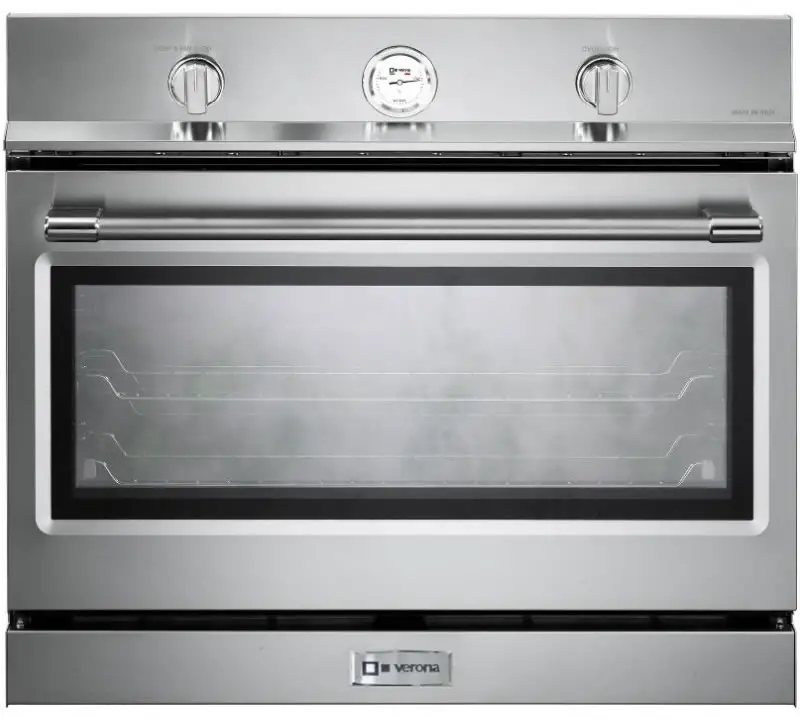
OPERATING INSTRUCTIONS
IMPORTANT – PLEASE READ AND FOLLOW
• Before beginning, please read these instructions completely and carefully.• Do not remove permanently affixed labels, warnings, or plates from the product. This may void the warranty.• Please observe all local and national codes and ordinances.• Please ensure that this product is properly grounded.• The electrical plug should always be accessible.• The installer should leave these instructions with the consumer who should retain for local inspector’s use and for future reference.
Installation must conform with local codes or in the absence of codes, the National Fuel Gas Code ANSI Z223.1/NFPA 54 – Iatest edition. Electrical installation must be in accordance with the National Electrical Code, ANSI/NFPA70 – latest edition and/or local codes.IN CANADA: Installation must be in accordance with the current CAN/CGA-B149.1 National Gas Installation Code or CAN/CGA-B149.2, Propane Installation Code and/or local codes. Electrical installation must be in accordance with the current CSA C22.1 Canadian Electrical Codes Part 1 and/or local codes.
INSTALLATION IN MANUFACTURED (MOBILE) HOME: The installation must conform with the Manufactured Home Construction and Safety Standard, Title 24 CFR, Part 3280 [formerly the Federal Standard for Mobile Home Construction and Safety, Title 24, HUD (Part 280)] or, when such standard is not applicable, the Standard for Manufactured Home Installations, ANSI/NCSBCS A225.1, or with local codes where applicable.
INSTALLATION IN RECREATIONAL PARK TRAILERS: The installation must conform with state or other codes or, in the absence of such codes, with the Standard for Recreational Park Trailers, ANSI A119.5.Installation of any gas-fired equipment should be made by a licensed plumber. A manual shut-off valve must be installed in an accessible location in the gas line external to the appliance for the purpose of turning on or shutting off gas to the appliance (In Massachusetts such shutoff devices should be approved by the Board of State Examiners of Plumbers & Gas Fitters).If an external electrical source is utilized, the appliance, when installed, must be electrically grounded in accordance with local codes or, in the absence of local codes, with the national Electrical Code, ANSI/NFPA 70.
Some models are supplied with a protective film on steel and aluminium parts. This film must be removed before installing/using the appliance.
Take care NOT to lift the oven by the door handle.
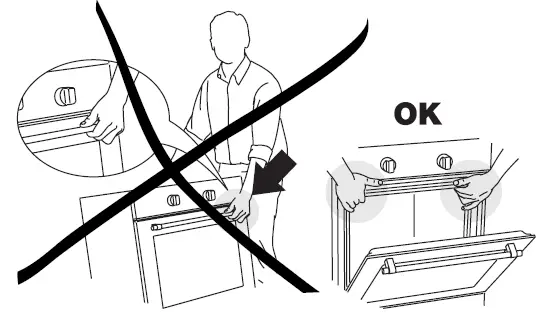
WARNING ! If the information in this manual is not followed exactly, a fire or explosion may result causing property damage, personal injury, or death.
- –Do not store or use gasoline or other flammable vapors and liquids in the vicinity of this or any other appliance.
- NEVER use this appliance as a space heater to heat or warm the room. Doing so may result in carbon monoxide poisoning and overheating of the appliance.
- WHAT TO DO IF YOU SMELL GAS:
- Do not try to light any appliance.
- Do not touch any electrical switch.
- Do not use any phone in your building.
- Immediately call your gas supplier from a neighbor’s phone. Follow the gas supplier’s instructions.
- If you cannot reach your gas supplier, call the fire department.
- Installation and service must be performed by a qualified installer, service agency, or the gas supplier.
Dear Customer,Thank you for having purchased and given your preference to our product.The safety precautions and recommendations reported below are for your own safety and that of others. They will also provide a means by which to make full use of the features offered by your appliance.Please preserve this booklet carefully. It may be useful in future, either to yourself or to others in the event that doubts should arise relating to its operation.This appliance must be used only for the task it has explicitly been designed for, that is for cooking foodstuffs. Any other form of usage is to be considered as inappropriate and therefore dangerous.The manufacturer declines all responsibility in the event of dama-ge caused by improper, incorrect or illogical use of the appliance.
WARNING: This product can expose you to chemicals including formaldehyde, which is known to the State of California to cause cancer, and lead, which is known to the State of California to cause birth defects or other reproductive harm. For more information go to www.P65Warnings.ca.gov
This appliance is designed and manufactured solely for the cooking of domestic (household) food and in not suitable for any none domestic application and therefore should not be used in a commercial environment.The appliance warranty will be void if the appliance is used within a none domestic environment i.e. a semi commercial, commercial or communal environment.
USER INSTRUCTIONS
GENERAL INFORMATION
- Installation must conform with local codes or, in the absence of local codes, with the National Fuel Gas Code, ANSI Z223.1/NFPA 54 – Latest Edition, CAN/CGA-B149.1 or CAN/CGA-B149.2.
- Installation in manufactured (mobile) home: installation must conform with the Manufactured Home Construction and Safety Standard, Title 24 CFR, Part 3280 [formerly the Federal Standard for Mobile Home Construction and Safety, Title 24, HUD (Part 280)] or, when such standard is not applicable, the Standard for Manufactured Home Installations, ANSI/NCSBCS A225.1, or with local codes where applicable.
- Installation in Recreational Park Trailers: installation must conform with state or other codes or, in the absence of such codes, with the Standard for Recreational Park Trailers, ANSI A119.5.
- WARNING!! This appliance shall not be used for space heating. This information is based on safety considerations.
- AlI openings in the wall behind the appliance and in the floor under the appliance shall be sealed.
- Keep appliance area clear and free from combustible materials, gasoline, and other flammable vapors.
- Do not obstruct the flow of combustion and ventilation air.
- Disconnect the electrical supply to the appliance before servicing.
- When removing appliance for cleaning and/or service;A. Shut off gas at main supply.B. Disconnect AC power supply.C. Disconnect gas line to the inlet pipe.D. Carefully lift appliance out of cabinet cutout. CAUTION: The appliance is heavy; use care in handling.
- Electrical RequirementElectrical installation should comply with national and local codes.
- Air Supply and VentilationThe installer must refers to local/national codes.
- Gas Manifold PressureNatural gas – 4.0” W.C.P.LP/Propane – 11.0” W.C.P.
- The misuse of oven door (e.g. stepping, sitting, or leaning on them) can result in potential hazards and/or injuries.
WARNING!! ELECTRICAL GROUNDING INSTRUCTIONSThe oven must be electrically grounded in accordance with local codes or, in the absence of local codes, with the National Electrical Code, ANSI/NFPA No. 70-latest edition, in Canada Canadian Electrical Code.Installation should be made by a Iicensed electrician.
FOR PERSONAL SAFETY, THIS APPLIANCE MUST BE PROPERLY GROUNDED.If an external electrical source is utilized, the installation must be electrically grounded in accordance with local codes or, in the absence of local codes, with the national Electrical Code, ANSI/NFPA 70.This appliance is equipped with a three-prong grounding plug (NEMA 5-15P) for your protection against shock hazard and should be plugged directly into a properly grounded socket.Do not under any circumstances cut or remove the third (ground) prong from the power plug.
REPLACEMENT PARTSOnly authorized replacement parts may be used in performing service on the appliance. Replacement parts are available from factory authorized parts distributors. Contact the nearest parts distributor in your area.
IMPORTANT PRECAUTIONS AND RECOMMENDATIONS
After having unpacked the appliance, check to ensure that it is not damaged. In case of doubt, do not use it and consult your supplier or a professionally qualified technician. Packing elements (i.e. plastic bags, polystyrene foam, nails, packing straps, etc.) should not be left around within easy reach of children, as these may cause serious injuries. The packaging material is recyclable and is marked with the recycling symbol .
• Do not attempt to modify the technical characteristics of the appliance as this may become dangerous to use.• Do not carry out cleaning or maintenance operations on the appliance without having previously disconnected it from the electric power supply.• After use, ensure that the knobs are in Off position.• Do not allow children or other incapable people to use the appliance without supervision.• During and after use of the oven, certain parts will become very hot. Do not touch hot parts.• Keep children away from the oven when it is in use.• Some models are supplied with a protective film on steel and aluminium parts. This film must be removed before installing/using the appliance.• Fire risk! Do not store flammable material in the oven.• Make sure that electrical cables connecting other appliances in the proximity of the oven cannot become entrapped in the oven door.• Do not line the oven walls with aluminium foil. Do not place shelves, broiler pan, pans or other cooking utensils on the base of the oven chamber.• The manufacturer declines all liability for injury to persons or damage to property caused by incorrect or improper use of the appliance.• To avoid any possible hazard, the appliance must be installed by qualified personnel only. Any repairs by unqualified persons may result in electric shock or short circuit. In order to avoid possible injuries to your body or to the appliance, do not attempt any repairs by yourself. Such work should be carried out by qualified service personnel only.• Important! The use of suitable protective clothing/gloves is recommended when handling, installing or cleaning of this appliance.• Danger of burns! The oven and cooking accessories may become very hot during operation. Make sure children are kept out of reach and warn them accordingly. To avoid burns use kitchen clothes and gloves when handling hot parts or utensils.• Stand away from the oven when opening oven door. Hot air or steam which escapes can cause burns to hands, face, and/or eyes.• The misuse of oven door (e.g. stepping, sitting, or leaning on them) can result in potential hazards and/or injuries.• DO NOT attempt to light the oven or broil burner during power failure.• Never clean the oven with a high-pressure steam cleaning device, as it may provoke a short circuit.• This appliance is intended for use in your household. Never use the appliance for any other purpose!• If you should decide not to use this appliance any longer (or decide to substitute an older model), before disposing of it, it is recommended that it be made inoperative in an appropriate manner in accordance to health and environmental protection regulations, ensuring in particular that all potentially hazardous parts be made harmless, especially in relation to children who could play with old appliances. Remove the door before disposal to prevent entrapment.
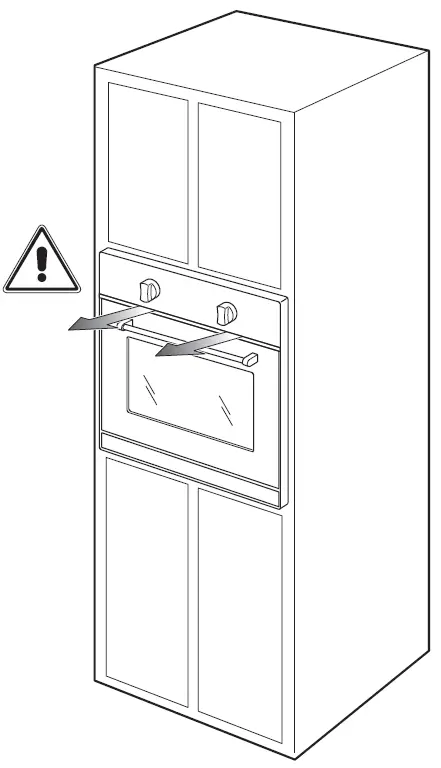
KEEP ATTENTION!! STAND AWAY FROM THE OPENING BELOW THE CONTROL PANEL (SEE FIGURE ABOVE). HOT AIR WHICH ESCAPES CAN CAUSE BURNS TO HANDS, FACE, END/OR EYES.
IMPORTANT PRECAUTIONS AND RECOMMENDATIONS FOR USE OF ELECTRICAL APPLIANCESUse of any electrical appliance implies the necessity to follow a series of fundamental rules.
In particular:
• Never touch the appliance with wet hands or feet.• Do not operate the appliance barefooted.• Do not allow children or disabled people to use the appliance without your supervision.The manufacturer cannot be held responsible for any damages caused by improper, incorrect or unreasonable use of the appliance.
control panel

1. Gas oven/gas broil control knob2. Oven light & fan control knob3. Oven thermometer
CAUTION: Gas appliances produce heat and humidity in the environment in which they are installed.Ensure that the cooking area is well ventilated following national/local codes.
COOLING FAN MOTORThis appliance incorporates a safety cooling fan motor to achieve optimum efficiency of the controls, ensure lower surface temperatures are maintained and cool the internal components.The cooling fan motor turns on automatically when igniting the oven or broil burner.It may run on (for various minutes) even after the oven or broil burner has been turned off.
How to Use the Gas Oven
GENERAL FEATURES
The gas oven is provided with:
- Oven burner, mounted on the lower part of the oven.
- Broil burner, mounted on the upper part of the oven.
- Fan motor which can be used in combination with the oven burner or separately (without heating). It is not possible to use the fan motor in combination with the broil burner: a safety device switches off the fan motor when the gas oven/broil control knob is turned on broil position.
- Light that illuminates the oven to enable visually controlling the food that is cooking.
Attention: the oven becomes very hot during operation.Attention: the oven door becomes very hot during operation. Keep children away.WARNING: The door is hot, use the handle.
OPERATING PRINCIPLES
Heating and cooking are obtained in the following ways:a. by normal convectionThe heat is produced by the oven burner.c. by forced convectionThe heat produced by the oven burner is distributed throughout the oven by the fan. The hot air envelops the food in the oven, provoking a complete and rapid cooking.It is possible to cook several dishes simultaneously.d. by radiationThe heat is irradiated by the infra red broil burner.f. by ventilation (this is not a cooking function)The food is defrosted by using the fan only without oven burner.
N.B. When the oven is not being used, set the control knobs to their Off positions and also close the gas shutoff valve placed on the main gas supply line.VERY IMPORTANT: The oven/broil shall be used always with the oven door closed.
USING THE OVEN FOR THE FIRST TIME
It is advised to follow these instructions:
- Furnish the interior of the oven by placing the wire racks as described at chapter “Cleaning and maintenance”.
- Insert shelf and tray.
- Turn the oven on to the maximum temperature (position 550) to eliminate possible traces of grease from the oven burner. The same operation should be followed for broil burner.
- Switch off the electrical supply, let the oven cool down, then clean the interior of the oven with cloth soaked in water and detergent (neutral) then dry carefully.

COOLING FAN MOTOR
This appliance incorporates a safety cooling fan motor to achieve optimum efficiency of the controls, ensure lower surface temperatures are maintained and cool the internal components.The cooling fan motor turns on automatically when igniting the oven or broil burner.It may run on (for various minutes) even after the oven or broil burner has been turned off.
IMPORTANT NOTES:
- DO NOT attempt to light the oven or broil burner during power failure.
- In case of failure of the cooling fan motor during the operation of the gas oven or gas broil, the oven or broil burner is turned off automatically after a few minutes. In that case do not use the oven or the broil and contact the aftersales service.
- Do not attempt to use the oven or broil if the cooling fan motor is damaged.
- When the cooling fan motor is operating correctly there is an air flow below the control panel.
OVEN BURNERIt carries out normal “oven cooking”. The gas flow to the burner is regulated by a thermostat which allow to maintain the oven temperature constant.The control of the temperature is assured by a thermostatic probe positioned inside the oven.The probe must be always kept in its housing, in a clean condition, as an incorrect position or encrustment may cause an alteration in the control of the temperature.
OVEN THERMOSTATThe numbers printed on the control knob (fig. 2.1a) indicate the increasing oven temperature value (°F- see also temperature table opposite).To regulate the temperature, set the chosen number onto the control panel indicator. The position serves only to turn on the broil burner.
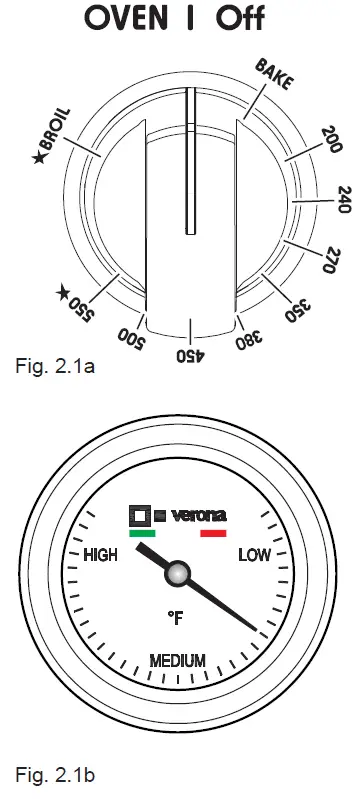
| KNOB SETTING | TEMPERATURE | |
| °F | °C | |
| 200 | 200 | 93 |
| 240 | 240 | 115 |
| 270 | 270 | 132 |
| 350 | 350 | 177 |
| 380 | 380 | 193 |
| 450 | 450 | 232 |
| 500 | 500 | 260 |
| 550 | 550 | 288 |
OVEN THERMOMETERThe thermometer allows to have a general (non-exhaustive) indication of the oven heating level (LOW, MEDIUM, HIGH) (fig. 2.1b).To set the temperature, always refer to the oven temperature (thermostat) control knob.
OVEN LIGHT AND FAN MOTORThe oven light and the fan motor are controlled by a switch knob on the control panel (fig. 2.2). To light up the oven lamp turn the knob counterclockwise to position.To operate the fan motor turn the knob clockwise to position. In this setting also the oven lamp is On.WARNING: The switch knob can be turned only clockwise from Off to position and counterclockwise from Off to position.The switch knob DOES NOT TURN from to position (and vice versa). DO NOT FORCE.IMPORTANT NOTE: The fan motor can be used in combination only with the oven burner. A safety device switches off the fan motor when the gas oven/broil control knob is turned on position.

IGNITION OF THE OVEN BURNER
IMPORTANT NOTE: during ignition of the oven burner the fan motor shall be switched Off (LIGHT & FAN control knob in Off position – fig. 2.2).The thermostat allows the automatic control of the temperature.The gas delivery to the oven burner is controlled by a two way thermostatic tap (oven and broil burners) with flame-failure device.To light the oven burner operate as follows:
- Open the oven door to its full extent.WARNING: Risk of explosion! The oven door must be open during this operation.
- Press the oven/broil control knob right down and turn counter-clockwise (fig. 2.3) to max position 550.
- Check the oven burner has lit; if not, turn the knob clockwise back to Off and repeat the procedure from step 2.
- Once the oven burner has lit, close the oven door slowly and adjust the burner according to the power required.
If the flame extinguishes for any reason, the safety valve will automatically shut off the gas supply to the burner.To re-light the burner, first turn the oven/broil control knob to position Off, wait for at least 1 minute and then repeat the lighting procedure.
VERY IMPORTANT NOTE: THE BURNER IGNITION PROCEDURE MUST ALWAYS START WITH THE CONTROL KNOB IN THE OFF POSITION OR IT WILL NOT BE POSSIBLE TO IGNITE THE BURNER.
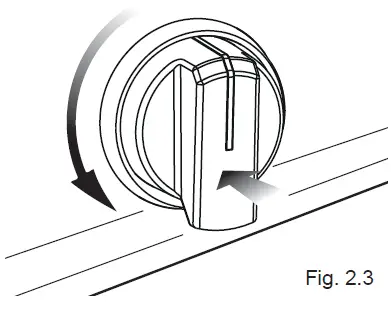
Do always bake with oven door closed.Attention: the oven door becomes very hot during operation. Keep children away.
TRADITIONAL BAKING (OVEN BURNER WITHOUT FAN MOTOR)
Before introducing the food, preheat the oven to the desired temperature.For a correct preheating operation, it is advisable to remove the tray from the oven and introduce it together with the food, when the oven has reached the desired temperature.Check the cooking time and turn off the oven 5 minutes before the theoretical time to recuperate the stored heat.
Recommended for:For foods which require the same cooking temperature both internally and externally, i.e. roasts, spare ribs, meringue, etc.
CONVECTION BAKING WITH VENTILATION (OVEN BURNER WITH FAN MOTOR)After lighting the oven burner switch on the fan motor by turning the LIGHT & FAN control knob (fig. 2.2) on position.Before introducing the food, preheat the oven to the desired temperature.For a correct preheating operation, it is advisable to remove the tray from the oven and introduce it together with the food, when the oven has reached the desired temperature.Check the cooking time and turn off the oven 5 minutes before the theoretical time to recuperate the stored heat.It is possible to cook various different foods at the same time. Fish, cakes and meat can be cooked together without the smells and flavours mixing.
The only precautions required are the following:
- The cooking temperatures must be as close as possible with a maximum difference of 70- 80 °F (20-25 °C) between the different foods.
- Different dishes must be placed in the oven at different times according to the cooking time required for each one. This type of cooking obviously provides a considerable saving on time and energy.
Recommended for:For foods of large volume and quantity which require the same internal and external degree of cooking; for ex: rolled roasts, turkey, legs, cakes, etc.
DEFROSTING FROZEN FOODS (ONLY FAN MOTOR)With the oven/broil burner control knob in Off position turn the LIGHT & FAN control knob (fig. 2.2) on position.Only the fan and the oven lamp switch On. Defrosting takes place by the fan, without heating.
Recommended for:To rapidly defrost frozen foods; 2.2 lbs (1 kg) requires about one hour.The defrosting times vary according to the quantity and type of foods to be defrosted.
IGNITION OF THE BROIL BURNER
IMPORTANT NOTE: the fan motor cannot be used in combination with the broil burner. A safety device switches off the fan motor when the gas oven/broil control knob is turned on position.The broil burner generates the infra-red rays for broiling.
To light the broil burner operate as follow:
- Open the oven door to the full extent.WARNING: Risk of explosion! The oven door must be open during this operation.
- Press the oven/broil control knob right down and turn clockwise (fig. 2.4) to the position.
- Check the broil burner has lit; if not, turn the knob counterclockwise back to Off and repeat the procedure from step 2.
- Once the broil burner has lit, close the oven door slowly.

If the flame extinguishes for any reason, the safety valve will automatically shut off the gas supply to the burner.To re-light, the burner, first turn the oven/broil control knob to position Off, wait for at least 1 minute and then repeat the lighting procedure.
VERY IMPORTANT NOTE: THE BURNER IGNITION PROCEDURE MUST ALWAYS START WITH THE CONTROL KNOB IN THE OFF POSITION OR IT WILL NOT BE POSSIBLE TO IGNITE THE BURNER.
Do always broil with oven door closed.Attention: the oven door becomes very hot during operation. Keep children away.

WARNING: It is advisable to handle the oven accessories using oven gloves.

BROILINGVery important: The broil burner must always be used with the oven door closed.
• Position the shelf on the first or second level from the top (fig. 2.5).• Turn on the broil burner, as explained in the preceding paragraphs and let the broil burner preheat for about 5 minutes with the door closed.• Place the food to be cooked above the broiling pan.• Introduce the broiling pan in the oven (fig. 2.6). The broiling pan should be placed above the shelf and it should be centered with the broil burner (fig. 2.5).
Do not broil without using the broiling pan.Important: Always use suitable protective gloves when inserting/removing the broiling pan, shelves, pans on other cooking utensils from the oven.
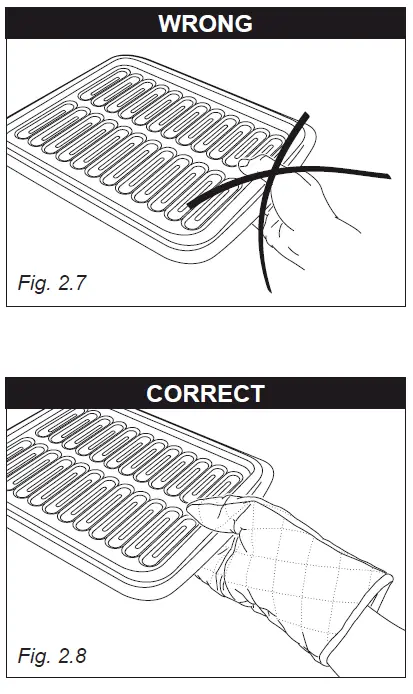
Cleaning And Maintenance
WARNING VERY IMPORTANT: Before any operation of maintenance disconnect the appliance from the electrical mains supply.
GENERAL RECOMANDATION
- Important: Before any operation of cleaning and maintenance disconnect the appliance from the electrical supply.
- It is advisable to clean when the appliance is cold and especially for cleaning the enamelled parts.
- Avoid leaving alkaline or acidic substances (lemon juice, vinegar, etc.) on the surfaces.
- Avoid using cleaning products with a chlorine or acidic base.
- IMPORTANT: The use of suitable protective clothing/gloves is recommended when cleaning and maintaining the appliance.
- WARNING When correctly installed, your product meets all safety requirements laid down for this type of product category. However special care should be taken around the rear or the underneath of the appliance as these areas are not designed or intended to be touched and may contain sharp or rough edges, that may cause injury.
ENAMELLED PARTS
- All the enamelled parts must be cleaned with a sponge and soapy water only or other non-abrasive products.
- Dry preferably with a microfibre or soft cloth.
- Acidic substances like lemon juice, tomato sauce, vinegar etc. can damage the enamel if left too long.
PAINTED PARTS AND SILK-SCREEN PRINTED SURFACESClean using an appropriate product. Always dry thoroughly.
IMPORTANT: these parts must be cleaned very carefully to avoid scratching and abrasion. You are advised to use a soft cloth and neutral soap.
STAINLESS STEEL ELEMENTS
• Stainless steel parts must be rinsed with water and dried with a soft and clean cloth.• For difficult dirt, use a specific non-abrasive product available commercially or a little hot vinegar.
INSIDE OF OVENThe oven should always be cleaned after use when it has cooled down.The cavity should be cleaned using a mild detergent solution and warm water. Suitable proprietary chemical cleaners may be used after first consulting with the manufacturers recommendations and testing a small sample of the oven cavity. Abrasive cleaning agents or scouring pads/cloths should not be used on the cavity surface.
NOTE: The manufacturers of this appliance will accept no responsibility for damage caused by chemical or abrasive cleaning.Let the oven cool down and pay special attention no to touch the hot heating elements inside the oven cavity.
OVEN FITTING OUT
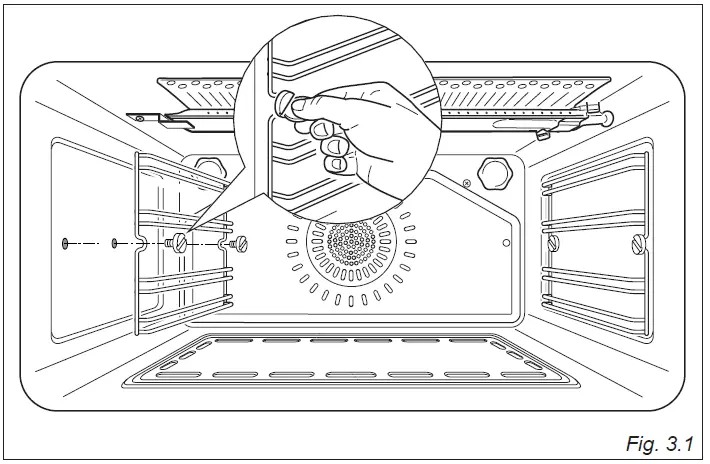
- Assemble the wire racks to the oven walls using the 2 screws (Fig. 3.1).
- Telescoping sliding shelf support (fig. 3.2): The telescopic sliding shelf support makes it safer and easier to insert and remove the oven shelf. It stops when it is pulled out to the maximum position. Important! When installing the sliding shelf support, make sure that:
- You fit the RH and LH sliding guides on the wire support (fig. 3.2).
- You press the RH and LH sliding guides against the fixing wires (figs. 3.2a, 3.2b). You will hear a click as the safety locks clip over the wire.You fit the oven shelf above the sliding shelf support (figs. 3.2c, 3.2d).You slide, on the guides inside the oven cavity, the sliding shelf support with the oven shelf fitted above:a. the oven shelf shall run out towards the oven door;b. the short bend on the wire support shall face the inside of the oven;c. the oven shelf must be fitted so that the guard rail faces the inside of the oven.
- Position the broiling pan above the oven shelf.
- To dismantle, operate in reverse order.To remove the RH and LH sliding guides from the wire support:
- Find the safety locks.These are the tabs that clip over the fixing wire (arrow 1 in fig. 3.2e).
- Pull the safety locks away from the fixing wire to release the sliding guide (arrow 2 in fig. 3.2e).
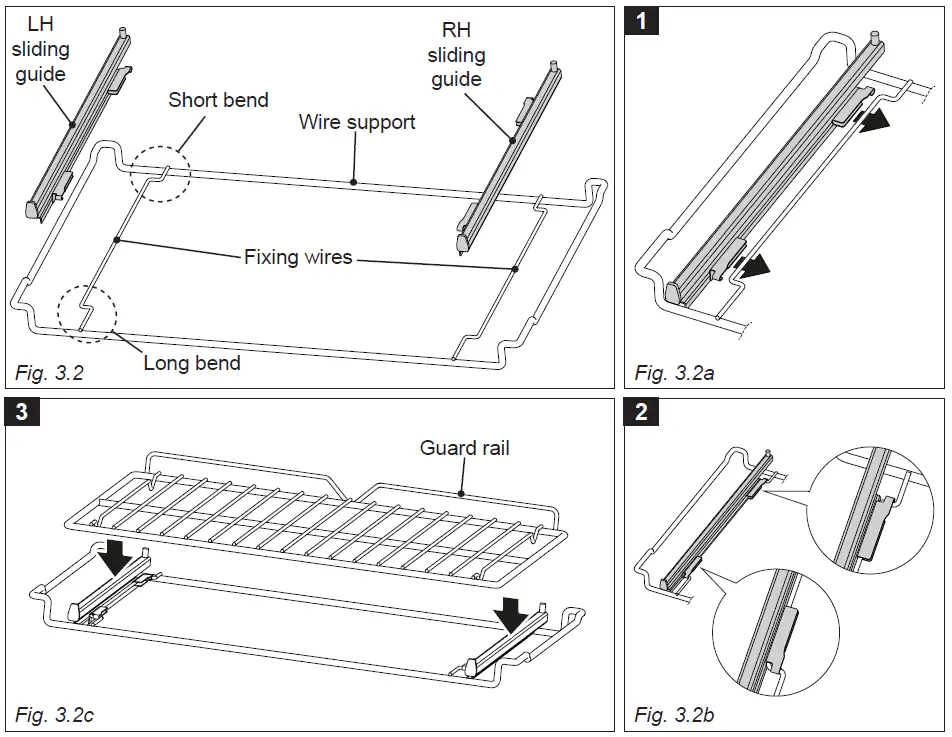

IMPORTANT: The oven shelf must be used only with telescopic sliding shelf support correctly in place. IT IS NOT POSSIBLE to fit the oven shelf directly on the guides inside the oven cavity.
REPLACING THE OVEN LIGHTSWARNING: Ensure the appliance is switched off before replacing the lamp to avoid the possibility of electric shock.
• Let the oven cavity and the heating elements to cool down.• Switch off the electrical supply.• Remove the protective cover “A” (fig. 3.3).• Replace the halogen lamp “B” with a new one suitable for high temperatures having the following specifications: 120 V, 60 Hz, G9 and same power (check watt power as stamped in the lamp itself) of the replaced lamp.IMPORTANT WARNING: Never replace the lamp with bare hands; contamination from your fingers can cause premature failure. Always use a clean cloth or gloves.• Refit the protective cover.
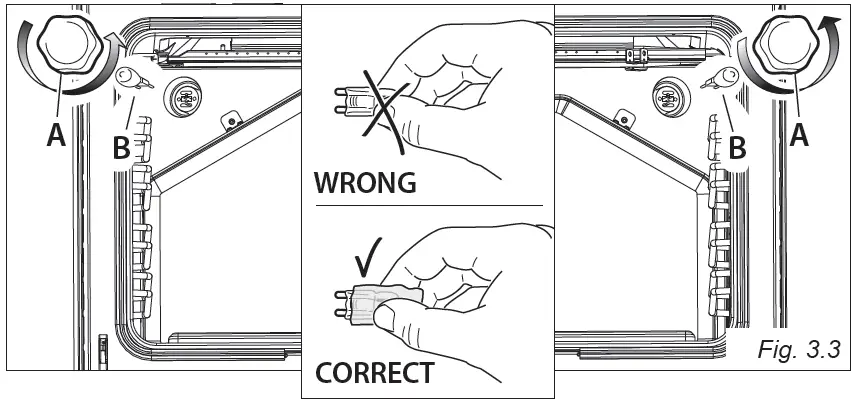
NOTE: Oven bulb replacement is not covered by your guarantee.
REMOVING THE OVEN DOOR
IMPORTANT!
• Take care, the oven door is heavy. If you have any doubts, do not attempt to remove the door.• Make sure the oven and all its parts have cooled down. Do not attempt to handle the parts of a hot oven.• Take extreme care when handling the door. Avoid the door and the glass panes bumping against any surface. This may result in the door damage or glass shattering.• If you notice any sign of damage on any of the glass panes (such as chipping, or cracks), do not use the oven. Call your Authorised Service Centre or Customer Care.• Important! Always keep a safe distance from the door hinges, paying special attention to the position of your hands.If the door hinges are not correctly hooked, they could unhook and close suddenly and unexpectedly with risk of injury.
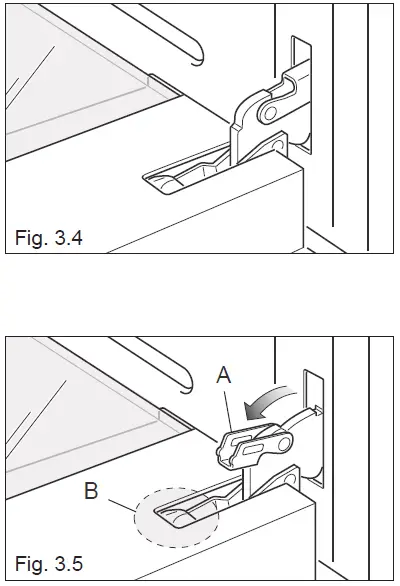
The oven door can easily be removed as follows:
1. Open the door to the full extent (fig. 3.4).2. Open the lever “A” completely on the left and right hinges (fig. 3.5).3. Hold the door as shown in fig. 3.6.4. Gently close the door until left and right hinge levers “A” are hooked to part “B” of the door (figs. 3.5, 3.7).5. Withdraw the hinge hooks from their location following arrow “C” (fig. 3.8).6. Rest the door on a soft surface.
REFIT THE DOOR
1. Hold the door firmly (fig. 3.9).2. Insert the hinge tongues into the slots, making sure that the groove drops into place as shown in the figure 3.10.3. Open the door to its full extent.4. Fully close the levers “A” on the left and right hinges, as shown in the figure 3.11.5. Close the door and check that it is properly in place.

DO’S AND DO NOT’S
• Do always use the oven with the door closed.• Do always broil with the oven door closed.• Do not use the oven to warm or heat a room.• Do read the user instructions carefully before using the oven for first time.• Do allow the oven to heat for about two hours, before using for the first time, in order to expel any smell from the new oven insulation, without the introduction of food.• Do clean your oven regularly.• Do remove spills as soon as they occur.• Do always use oven gloves when removing food shelves and trays from the oven.• Do not allow children near the oven when in use.• Do not allow fat or oils to build up in the oven base, or oven accessories.• Do not place cooking utensils or plates directly onto the oven base.• Do not broil without using the broiler pan.• Do not place hot enamel parts in water. Leave them to cool first.• Do not allow vinegar, coffee, milk, saltwater, lemon or tomato juice to remain in contact with enamel parts (i.e. inside the oven).• Do not use abrasive cleaners or powders that will scratch the surface of the stainless steel or painted surfaces and the enamel.• Do not attempt to repair the internal workings of your oven.• Some models only: Do remove the protective film before the first use.• Fire risk! Do not store flammable material in the oven.
FOR YOUR SAFETYUnder no circumstances should any external covers be removed for servicing or maintenance except by suitably qualified personnel.
The manufacturer cannot be held responsible for possible inaccuracies due to printing or transcription errors in the present booklet.The manufacturer reserves the right to make all modifications to its products deemed necessary for manufacture or commercial reasons at any moment and without prior notice, without jeopardising the essential functional and safety characteristics of the appliances.
References
[xyz-ips snippet=”download-snippet”]



